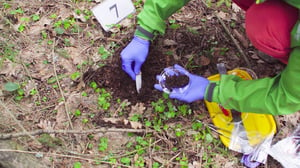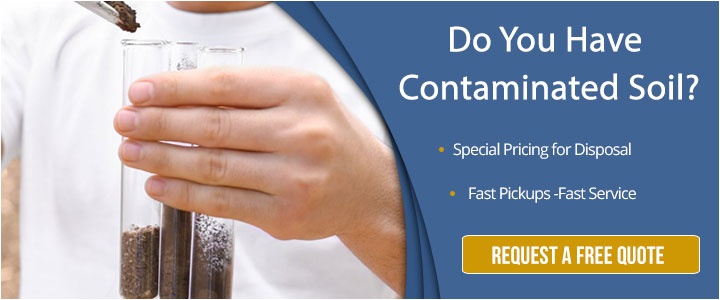The earth beneath our feet holds secrets that can surprise even the most seasoned builders.
Unearthing the hidden history of soil may reveal more than just its geological composition. It could also expose a lurking menace in the form of soil contamination.
As construction teams dig into the ground, the potential discovery of hazardous substances from bygone industrial activities or improper waste disposal can pose significant challenges. Not discovering contaminated soil until it is taken to a landfill can add another layer or challenges and complexity.
Disposal sites will often test soil before it can be left in their possession. If a soil contamination test reveals any contaminants, you may have to put your project on hold while you determine how to safely dispose of your contaminated soil.
What’s the next step? If you aren’t already working with a hazardous waste disposal company that has a network of resources available to it, now is the time to find one.
What Testing Can Unveil
Soil testing at landfills can vary depending on the state and local regulations, as well as the specific policies of the landfill operators. In many cases, when soil is dropped of at a landfill for disposal, the landfill may conduct some form of testing or screening to assess the soil’s suitability for acceptance.
the landfill operators. In many cases, when soil is dropped of at a landfill for disposal, the landfill may conduct some form of testing or screening to assess the soil’s suitability for acceptance.
In other cases, you may unearth contaminates at a project site during routine soil tests that are part of the project plan.
In either situation, it is vital to ensure that the contaminated soil is properly remediated or transferred to a disposal site that WILL accept the soil.
The specific contaminants tested for can vary depending on the location and local regulations. However, here are some common contaminants that you may discover in soil sample results:
- Heavy Metals: Contaminants such as lead, mercury, cadmium, arsenic and chromium can come from various sources, including industrial waste, batteries, electronics and certain household products. Particularly children are at a higher risk of developing complications from products like lead-based paint.
- Volatile Organic Compounds (VOCs): These are organic chemicals that can easily evaporate into the air and include substances like benzene, toluene, xylene and chlorinated solvents. VOCs are often found in industrial waste, certain cleaning products and some paints.
- Polycyclic Aromatic Hydrocarbons (PAHs): PAHs are a group of chemicals that can form during the incomplete burning of materials like coal, oil, gas and garbage. They are often present in contaminated soil or waste.
- Pesticides and Herbicides: Agricultural waste and certain industrial activities may introduce modern synthetic pesticides and herbicides into the landfill, and these toxic sprays and substances can be harmful to the environment.
- Asbestos: In urban soils, building materials like insulation, tiles and roofing may contain asbestos, which can seep into the soil when a new home is being built or a current home is being renovated. If these toxic materials are improperly disposed of, they can contaminate the soil.
- Polychlorinated Biphenyls (PCBs): PCBs were once used in electrical equipment, and their improper disposal can lead to soil contamination.
- Radioactive Materials: Some waste materials, such as those from nuclear or medical facilities, may contain excessive levels of radioactive substances that can be hazardous to human health and the environment.
- Medical Waste: Medical waste includes items such as sharps (needles), pharmaceuticals and infectious materials found in laboratories. These are sometimes found in soil or water when proper medical waste disposal did not occur.
- Hazardous Household Products: Certain household items, such as paint, batteries, electronics and cleaning chemicals, contain hazardous materials that require careful handling and disposal.
- Chemicals from Industrial Processes: Waste generated from various industrial processes may contain a wide range of chemicals that need testing to ensure safe disposal.
Proper testing for these contaminants helps protect the environment, public health and your company, ensuring you are in compliance with environmental regulations. If the soil health results aren’t what you had hoped, the good news is that there is help available.
How A Hazardous Waste Disposal Company Can Help
Sometimes doing the right thing can unearth surprises. You may have tested the soil at a construction site and gotten the all-clear after a little detective work. You then transported the excavated soil to a disposal facility, but surprise! Testing conducted at the disposal site reveals there are high enough concentrations of industrial pollutants present.
Excessive levels of any contaminant will cause you to have to switch gears and address a new problem. Now you must arrange for that soil to be transported from the landfill to the appropriate facility that will accept the contaminated soil.
As a project manager or business owner, searching for a landfill that will accept your industrial waste can be time-consumiing, causing your focus to be taken away from the project at-hand.
Hazardous waste disposal companies can help by removing the contaminated soil and transporting it to the appropriate facilities, even if those landfills are elsewhere in the United States and across the California state line.
Finding the right hazardous waste disposal services to help you with this process is essential in an already stressful situation. The best soil contamination services will:
- Work with you to develop a transportation plan, whether it’s from a property to a disposal site, or from one disposal site to another
- Complete any required manifests or paperwork
- Provide proof that your contaminated soil has been properly disposed of and has reached its final destination
- Be registered with the Department of Toxic Substances Control (DTSC), with information available on the DTSC’s Registered Hazardous Waste Transporter Database
- Offer a hazardous waste walk-through program that can help you identify potentially contaminated soil and help you ensure your waste management plans are in top shape.
- Provide a hazardous waste disposal free quote for your waste removal needs
It’s often beneficial to forge a relationship with an experienced hazardous waste disposal company before your project even begins. The best partners will offer hazardous waste determination services through sampling and profiling to determine soil quality.
A licensed contaminated waste removal company will test and classify the soil early in the process so you aren’t surprised by a positive soil sample at the landfill. An extra benefit to this service is that if the soil isn’t hazardous, you won’t have to pay the added costs that come with specialized hazardous waste removal.


Comment